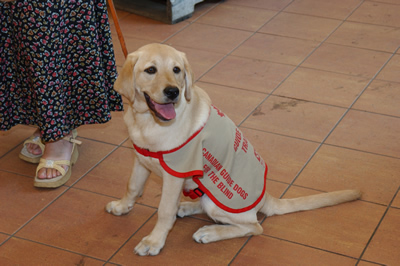April 27th was National Guide Dog Day. Guide Dogs are some of the most incredible animals out there; the ways in which they enrich their companion’s life is indescribable. In honor of Guide Dog Day we thought we would share some interesting facts about these amazing creatures.
There are many different organizations that provide guide and service dogs:
There are also many other types of service dogs: Hearing dogs, autism dogs, epilepsy dogs, diabetic assistant dogs, dogs for the physically impaired –quadriplegic and paraplegic dogs.
What are Guide Dogs?
In general, guide dogs are professionally trained dogs used to assist individuals who are blind or visually impaired. They also provide their handler with independence, confidence, mobility, safety and companionship, while guiding them around obstacles, through intersections, to stairs, doors and other landmarks.
Interesting facts:
-The first guide dog school opened in 1916, although mention of blind individuals using trained dogs to guide them dates back to 1780.
-Traditionally, guide dogs have been Labrador Retrievers, Golden Retrievers and German Shepherds. These breeds were chosen because of their intelligence, obedience, stamina and friendliness. In more recent years, Labradoodles are being trained as guide and service dogs.
-Guide dogs begin their training as puppies. Training takes about 2 years. The puppies start training with a volunteer to learn basic commands as well as to gain exposure to many different situations. They then complete their training with a professional guide dog trainer.
-Individuals are chosen based on intelligence, willingness to learn, ability to concentrate for long periods of time, attention to touch and sound, memory and health.
-Not all dogs graduate to become guide dogs. Reason a dog might fail: anxiety, fearfulness, nervousness, extreme reaction to other dogs/cats.
-Failed dogs will be found loving homes by the school, some placed in a home/environment where a well trained dog is required.
-Guide Dog training never involves food, it’s important that the dogs are not distracted/temped by food while on the job
-One of the most important things a guide dog needs to know is to stop at curbs
-Guide dogs practice “selective obedience” –they follow commands from their handler, but must also know to disobey commands that would put the handler in danger.
-Each guide dog is specially matched to their handler –matching is based on things such as height, walking speed, age, and home environment.
-Each half of the team, the dog and the handler, work together, the handler giving commands and reading the dogs movement. Each half of the team relies on the other to accomplish the task
-Handlers go through weeks of training themselves
-When the dogs are not wearing their harness’ they know they are not working and act like any other pet dog –play, relax, and enjoy treats.
-Veteran dogs that are familiar with their routes need only direction from handler such as “Go to the office” and the dog knows where to go.
-Guide Dogs generally work until they are about 10 years of age, at which point they retire. Retired dogs are often rehomed, although some handlers do keep their retired guide dogs.
Here at Amherst Veterinary Hospital, we have the honor of being trusted with the care of many guide and service dogs, working and retired. It is obvious how seriously these dogs take their jobs and how special the bond is between handler and dog.


